Washington D.C. – US President Donald Trump has escalated tensions with Moscow by threatening unprecedented Trump Russia Tariffs of 100% if Russia fails to agree to a Ukraine war resolution within 50 days. This dramatic announcement represents the most aggressive economic threat against Russia since the conflict began.
Trump Announces Severe Economic Measures
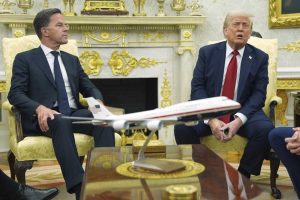
During a high-profile meeting with NATO Secretary-General Mark Rutte at the White House on July 14, Trump outlined his comprehensive strategy involving Trump Russia Tariffs and secondary sanctions. The President’s stark ultimatum reflects growing frustration with Russia’s prolonged military campaign in Ukraine.
“We’re very, very unhappy with them. And we’re going to be doing very severe tariffs if we don’t have a deal in 50 days. Tariffs at about 100 per cent, you’d call them secondary tariffs,” Trump declared during the meeting.
The Trump Russia Tariffs proposal extends beyond direct Russian trade, encompassing secondary sanctions targeting countries that purchase Russian energy products. White House officials confirmed that these measures would significantly impact global energy markets and trading relationships.
NATO Partnership Strengthens Ukraine Support
Alongside the tariff announcement, Trump and Rutte revealed a new mechanism ensuring continuous American weapons flow to Ukraine through NATO member nations. This partnership represents a strategic shift in how military aid reaches Ukrainian forces, potentially accelerating weapons delivery and improving coordination among allied nations.
The Trump Russia Tariffs initiative coincides with this expanded military support framework, creating a dual-pressure approach combining economic penalties with enhanced defensive capabilities for Ukraine. This comprehensive strategy demonstrates Trump’s commitment to resolving the conflict through multiple diplomatic and economic channels.
Secondary Sanctions Target Energy Buyers
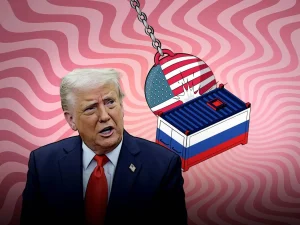

The proposed Trump Russia Tariffs system includes “secondary tariffs” affecting countries purchasing Russian energy products. This approach could significantly impact major Russian energy customers, including India and China, both substantial importers of Russian fossil fuels.
Trump described these Trump Russia Tariffs as “biting” and “powerful,” suggesting they would create substantial economic pressure on Russia’s energy sector. The secondary sanctions component represents an innovative approach to international economic warfare, potentially disrupting established energy trading patterns.
Also Read: Jaishankar In China Visit Marks First Trip Since 2020 Galwan Clash
Recent data indicates India was the second-largest buyer of Russian fossil fuels in May 2025, purchasing approximately €4.2 billion worth of energy products, with crude oil comprising 72% of total purchases. These Trump Russia Tariffs could fundamentally alter such trading relationships.
Congressional Support for Expanded Sanctions
The Trump Russia Tariffs proposal aligns with growing Congressional momentum behind the Sanctioning Russia Bill 2025, currently advancing through the United States Senate. This legislation proposes even more severe 500% tariffs on countries purchasing Russian energy products.
Senator Lindsey Graham, a Republican and close Trump ally, has championed this bill alongside Democratic Senator Richard Blumenthal. The bipartisan support demonstrates widespread political backing for aggressive economic measures against Russia and its trading partners.
The Sanctioning Russia Bill includes provisions allowing presidential waivers for specific countries during select periods. Trump has expressed support for these waiver provisions, providing flexibility in implementing Trump Russia Tariffs while maintaining diplomatic leverage.
Presidential Disappointment with Putin
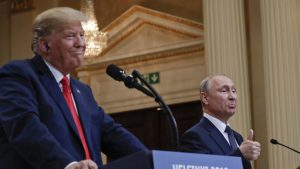

Trump’s Trump Russia Tariffs announcement reflects his personal disappointment with Russian President Vladimir Putin’s approach to negotiations. “I’m disappointed in President Putin, because I thought we would have had a deal two months ago,” Trump stated during the NATO meeting.
This frustration has motivated the aggressive Trump Russia Tariffs strategy, representing a significant escalation from previous diplomatic approaches. The 50-day deadline creates urgency for Russian decision-makers while providing clear consequences for continued conflict.
Global Economic Implications
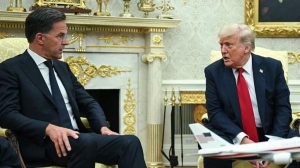

The proposed Trump Russia Tariffs could reshape international energy markets and trading relationships worldwide. Countries heavily dependent on Russian energy imports face difficult choices between maintaining current arrangements and avoiding severe economic penalties.
India’s External Affairs Minister S. Jaishankar has confirmed that the Indian Embassy in Washington DC maintains active communication with Senator Graham regarding concerns about the sanctions bill. This diplomatic engagement highlights the global significance of Trump Russia Tariffs implementation.
Strategic Timeline and Implementation
The 50-day deadline for Trump Russia Tariffs implementation creates immediate pressure on Russian leadership while providing sufficient time for serious negotiations. This timeline balances urgency with realistic diplomatic possibilities, potentially opening pathways for conflict resolution.
The comprehensive approach combining direct tariffs, secondary sanctions, and enhanced military support represents a sophisticated strategy addressing multiple conflict dimensions simultaneously. Success depends on international coordination and sustained pressure on Russian decision-makers.
Concluding Statement
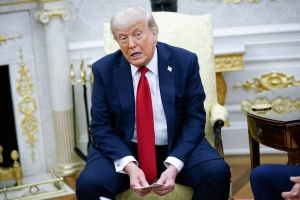
The Trump Russia Tariffs initiative represents the most aggressive economic strategy yet proposed against Russia regarding the Ukraine conflict. With bipartisan Congressional support and NATO partnership backing, these measures could significantly impact global energy markets and international relations. The 50-day deadline creates immediate urgency while the comprehensive approach addresses both economic and military dimensions of the ongoing conflict.

